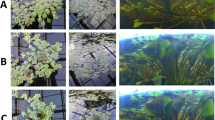Summary
The approximately diurnal movements of the flowers ofKalanchoe blossfeldiana come to a standstill after several days if they are kept in continuous light (LL) or darkness (DD). In LL (“White”) the flowers are closed and in DD they are opened. The rhythmical movement can be reinitiated by transfering the flowers from one continuous condition to the other.
In the present investigation we have studied the effects of various wavelengths of light upon this phenomenon. The results were as follows:
-
1.
The induced rhythmical movement in the case of a transfer from DD to LL as well as in the case of a transfer from LL to DD is controlled by light absorbed by the chlorophylls.
-
2.
The general tendency of the flowers to close their corollas during LL is induced by red light acting most probably through the agency of phytochrome.
Zusammenfassung
Die tagesperiodische Blütenblattbewegung beiKalanchoe blossfeldinana hört nach einigen Tagen Dauerlicht (LL) oder Dauerdunkel (DD) auf. Im LL (“wieß”) sind die Blüten dann geschlossen, im DD-geöffnet. Die rhythmische Bewegung kann wieder ausgelöst werden durch den einmaligen Übergang von einer Dauerbedingung (DD oder LL) in die andere (LL oder DD).
In der vorliegenden Arbeit haben wir die Wirkung verschiedener Wellenlängenbereiche des LL auf die Auslösung der Rhythmik untersucht. Es ergab sich:
-
1.
Sowohl beim Übergang von DD zu LL als auch beim Übergang von LL zu DD wird die Auslösung der rhythmischen Bewegung durch solches Licht kontrolliert, das vom Chlorophyll absorbiert wird.
-
2.
Die allgemeine Tendenz der Blüten, sich in LL zu schließen, beruht auf dem Rotlicht. Höchstwahrscheinlich wirkt es über das Phytochromsystem.
Similar content being viewed by others
Literature
Bünsow, R.: Über den Einfluß der Lichtmenge auf die endogene Tagesrhythmik beiKalanchoe blossfeldiana. Biol. Zbl.72, 465–477 (1953a).
—: Endogene Tagesrhythmik und Photoperiodismus beiKalanchoe blossfeldiana. Planta (Berl.)42, 220–252 (1953b).
Engelmann, W.: Endogene Rhythmik und photoperiodische Blühinduktion beiKalanchoe. Planta (Berl.)55, 496–511 (1960).
Hastings, J. W., andB. M. Sweeney: TheGonyaulax clock. In: Photoperiodism and rel. Phen. in Plants and Animals. Washington 1959.
Mohr, H., u.G. Schoser: Eine Interferenzfilter-Monochromatoranlage für photobiologische Zwecke. Planta (Berl.)53, 1–17 (1959).
Sweeney, B. M., F. T. Haxo andJ. W. Hastings: Action spectra for two effects of light on luminescence inGonyaulax polyedra. J. gen. Physiol.43, 285–299 (1959).
Wilkins, M. B.: The effect of light upon plant rhythms. Cold Spr. Harb. Symp. quant. Biol.25, 115–129 (1960).
Zimmer, R.: Unpublished.
Author information
Authors and Affiliations
Additional information
With 12 Figures in the Text
Rights and permissions
About this article
Cite this article
Karvé, A., Engelmann, W. & Schoser, G. Initiation of rhythmical petal movements InKalanchoe blossfeldiana by transfer from continuous darkness to continuous light or vice versa. Planta 56, 700–711 (1961). https://doi.org/10.1007/BF01928213
Received:
Issue Date:
DOI: https://doi.org/10.1007/BF01928213




